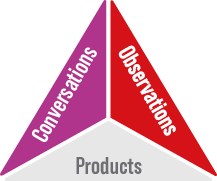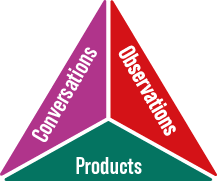F1. Money and Finances
Demonstrate the knowledge and skills needed to make informed financial decisions.
Learning Situation: Games for the Playground!
Duration: approximately 120 minutes
Overview
In this learning situation, students perform calculations to determine the total cost of various sports equipment for the classroom. In addition, the students will determine the best method of payment for each transaction and justify their choice. For the simulation of a cash transaction, change will be calculated.
|
Overall Expectation |
Specific Expectations |
|
F1. Financial Literacy Demonstrate the knowledge and skills needed to make informed financial decisions. |
F1.1 Identify various methods of payment that can be used to purchase goods and services. F1.2 Estimate and calculate the cost of transactions involving multiple items in whole-dollar amounts not including sales tax, and the amount of change needed when payment is made in cash, using mental math. |
| Preferred High-Impact Instructional Practices in Mathematics | Description |
|---|---|
|
Learning Goals, Success Criteria and Descriptive Feedback |
Before beginning this learning situation, it is essential to make the learning goals, based on the curriculum expectations and content, explicit so that they are known and understood by all students. This will ensure that students are aware of the learning goals of the lesson. The success criteria can then be developed and understood through a variety of instructional strategies, such as using examples of student work, co-constructing the success criteria or self-assessing how the criteria have been met. These strategies allow for student engagement and a shared understanding of the steps needed to achieve the learning goals. It is important to make the learning goals and success criteria visible by posting them in the classroom for students to refer to throughout the lesson. Descriptive feedback related to the criteria provides the specific information students need to achieve the intended learning goals. By providing descriptive feedback on multiple occasions, educators help students develop the skills to assess their own learning and reflect on the criteria. In this learning situation, a good time for descriptive feedback is during the problem solving. In small groups, students estimate and calculate the cost of transactions, explore various methods of payment, and choose play items for recess that best meet the needs of the students in their class. Students work and communicate in small groups, and, with thoughtful questioning, educators check for understanding and direct students to the criteria to adjust or justify their work. During the Review phase, mathematical conversations may require descriptive feedback from educators as they probe for students' reasoning about their choices when establishing a budget, and the strategies they used to calculate the cost of transactions and the unit prices. |
|
Problem-Solving Tasks and Experiences |
This learning situation, where the student must make several combinations of Canadian currency, is a problem-solving experience, as it gives students the opportunity to reason, communicate, represent, make connections, and justify thinking. In addition, the student must estimate and calculate the cost of selected items using various methods of payment. This learning situation has many entry points, and all students will be able to participate and propose solutions using their strategies, as well as their critical and creative thinking. This approach promotes accessibility for all students and the exchange of a variety of mathematical strategies and ideas. This learning situation can be differentiated by using different numbers for the work teams (smaller budget, therefore less complex or larger budget, therefore more complex), making the task accessible yet challenging for the students. |
|
Math Conversations |
By planning lessons like this, which emphasize collaboration and groupwork, the math conversations are ongoing. These conversations allow students to express themselves and react to the mathematical ideas presented. The role of educators will be to ask open-ended, thought-provoking questions to stimulate thinking and allow for multiple responses. This interaction through questioning must be carefully planned to highlight key concepts, skills, or specific representations to promote student progress. Educators are encouraged to anticipate students' questions and answers in order to make the exercise even more strategic (for example, by anticipating some common errors). As soon as the learning situation begins, educators should ask questions that are accessible to all students and encourage them to share their ideas in the class group. As students are engaged in solving the problem, questioning and discussion should promote their reasoning and justification as a group and develop their critical thinking. During Review, the questioning should support rich mathematical conversation in the whole group and provide educators with the opportunity to assess student understanding of the concepts being learned. |
Prior Knowledge and Skills
To be able to complete this learning situation, students must be able to:
- Add whole numbers.
- Round decimals to the nearest whole number.
- Use mental math strategies to add whole numbers.
- Remember multiplication facts up to 10 x 10.
- Represent and solve problems relating to the multiplication of a two-digit whole number by a one-digit whole number.
Learning Goals
At the end of this learning situation, the student will be able to:
- Estimate and calculate the cost of various transactions.
- Represent and solve problems of addition and subtraction of whole numbers.
- Determine various methods of payment.
- Determine the best product according to the class's needs.
Possible Success Criteria Based on the Achievement Chart
| Skill | Success Criteria |
|---|---|
|
Knowledge and Understanding |
The student understands the concept of estimation. The student defines what constitutes a method of payment. The student names different methods of payment. |
|
Thinking |
The student selects strategies for adding and subtracting costs, as well as effective strategies for mental calculation. The student chooses the right data, the appropriate operations as well as the method of payment according to the situation and the preferences of the individual. The student evaluates whether the price of an object constitutes a good purchase. |
|
Communication |
The student communicates mathematical reasoning using financial literacy conventions and terminology using drawings, explanations, and manipulatives. The student organizes their calculations by showing their work. |
|
Application |
The student uses mental math strategies to estimate the cost of the transaction. The student completes transactions involving several items, by calculating the cost of transactions comprising several items. |
Materials
- list of websites or catalogs of equipment for recess
- Appendix 1 (Playground Equipment for Recess)
- Appendix 2 (Methods of Payment)
- calculators
- Canadian play money kit
- dry-erase markers
- erasable whiteboard
- markers
- chart paper
- paper
Mathematical Vocabulary
method of payment, cheque, debit card, credit card, electronic wallet, good, service, transaction, cash
Before Learning (Warm-Up)
Duration: 30 minutes
Assessment can be carried out through…
Facilitate a discussion with students by asking the following questions and use the images (Appendix 2 - Methods of
Payment) below to engage students in the conversation:


- What does "method of payment" mean?
- Can you name different methods of payment that your family members use?
- What methods of payment do your parents use to purchase goods or services?
- What are the advantages and disadvantages of the different methods of payment?
- Can we always use any methods of payment?
- Is it important to estimate the total transaction cost of purchasing multiple items if you are paying with cash? If you pay
with a debit card? Why? - How do you know if you are making a good purchase? How do you know if the price is reasonable?
Active Learning (Exploration)
Duration: 50 minutes
Assessment can be carried out through…
Form teams of two students.
Provide students with the necessary materials.
Present the scenario below to the students:
Your school's school council is offering school staff up to $250 to purchase playground equipment for their students. They should keep their receipts and submit them for reimbursement afterwards. Your teacher asks for your help in determining what could be purchased.
Brainstorm with students about what game items to purchase, knowing there is a budget of $250.
Students make their own list of equipment using an Internet search or catalogs provided by educators.
Note: Appendix 1 - Playground Equipment for Recess provides examples of game items and their prices.
Explain to students that each team will have to choose a method of payment to pay for the items and justify their choice.
Students should explain how to use this method of payment and why it is a good choice.
Note: Becoming familiar with the various methods of payment people use to purchase goods and services allows students to
develop consumer awareness as well as an understanding of the factors that influence the choice of a method of payment.
Inform the students that during the Review phase, they will have to present and justify the list of items and the strategies
used to perform the calculations, while explaining the method of payment chosen. Emphasize the importance of making
estimations beforehand rather than applying algorithms immediately.
Allow enough time for them to complete the task. Circulate in the classroom and observe the strategies used by the
students. Provide support as needed to help some groups progress by asking scaffolded questions (see below).
Make sure that the students understand the task at hand by asking questions such as:
- Who can describe the task in their own words?
- What data is relevant in this situation?
|
Possible Observations |
Possible Interventions |
|
The group has difficulty recognizing useful information. |
|
|
There is too much data, and the team is unable to do |
|
|
The group fails to target a strategy to calculate the total cost of transactions. |
|
|
The group cannot justify its choice of method of payment. |
|
|
The group is unable to target a strategy to calculate the amount to be returned following a cash transaction. |
|
|
The group can't decide which equipment best suit their class. |
|
Possible Answer
Group 1 - Here is our list compiled using Appendix 1 - Playground Equipment for Recess, as well as our estimations of the total cost:
- Six scoop ball sets - $76 (approximately $80)
- Four inflatable rubber balls – 4×$12 is approximately 4×$10, so $40
- Set of 6 skip ball jumping rings – $33 (approximately $30)
- Four basketballs – 4 × $20 = $80
- Two sets of tennis balls – 2×$6 is approximately 2×$5, so $10
\($80 + $40 + $30 + $80 + $10 = $240 \)
Here are our choices and calculations:
- Six scoop ball sets – $76
-
Four inflatable rubber balls -
\(\displaylines{\begin{align} 4 \times $12 &= (4 \times 10) + (4 \times 2) \\ &= 40 + 8 \\ &= $48 \end{align}}\)
- Set of 6 skip ball jumping rings – $33 (approximately $30)
-
Four basketballs –
\(\displaylines{\begin{align} 4 \times $20 &= (4 \times 10) + (4 \times 10) \\ &= 40 + 40 \\ &= $80 \end{align}}\)
- Two sets of tennis balls – 2 × $6 = $12
Total cost
\(\displaylines{\begin{align} 76 + 48 + 33 + 80 + 12 &= 76 + (48 + 12) + (33 + 80) \\ &= 76 + 60 + 113 \\ &= 136 + 113 \\ &= $249 \end{align}}\)
We used cash because it's easier to control expenses. With a budget of $250, it's easier to see how much money we have left and
how much money is being spent as we go. Change to be returned is $1.
In order to choose the equipment that best meet the needs of our class, I have to think about the age group of the students as
well as their preferences. I also have to justify my choices. I prepared a table with the data.
|
Equipment |
Justification |
|
Tennis balls |
Some students like to play catch with tennis balls. |
|
Inflatable rubber balls |
Many students in our class enjoy playing the 4 corners game, this type of ball is perfect! |
|
Basketballs |
Students like to play Horse Game or 21. |
|
$319 play item set shared with the other Grade 4 class |
There are a variety of play items, including skipping ropes. Some students enjoy skipping rope. |
If I were to make the same table for a Grade 1 class, the choices would be different due to age and areas of interest.
|
Equipment |
Justification |
|
Six scoop ball sets |
This game is good for working on motor skills, which is important for students in Grade 1. It can be played with 2 or more children. Most children enjoy playing with others. |
|
Set of 6 skip ball jumping rings |
This game is individual, as sometimes students prefer this type of game. |
|
Velcro ball game set |
This game is good for working motor skills in students. It is played with 2 or more players. |
|
Inflatable rubber balls |
Often the youngest like to jump or dribble a big ball with their friends. |
|
Hoops |
Students can create a hopscotch game with hula hoops. |
Ask the teams to compare their results with those of another team.
Post the calculations as well as the explanation and justification of the students' choice of methods of payment on the wall and offer them the opportunity to make comments and ask questions to the different groups by posting sticky notes on the solutions that interest them. Ensure that questions and comments are constructive and linked to the learning goals and success criteria.
Get the students thinking by asking them the following questions: Compare your results with those of another group. Are
you satisfied with your solution? If yes, explain why. Otherwise, modify your solution.
Review
Duration: 30 minutes
Assessment can be carried out through…
By highlighting a few examples of students' strategies and specific reflections that are related to the learning goals and the success criteria, lead a mathematical conversation to elicit the strategies and the skills used and the knowledge acquired.
- How did you choose the appropriate equipment for the different classes?
- Was your estimation accurate enough?
- What strategies did you use to calculate the cost?
- Why do you think we put a set of game items worth over $250 in the Appendix 1 - Playground Equipment for Recess?
Possible Answer
Another class can be asked to join us in purchasing other game items with the difference of $181.
\(\displaylines{\begin{align} 500 \ - \ 319 &= \ ? \\ 319 + 1 &= 320 \\ 320 + 80 &= 400 \\ 400 + 100 &= 500 \\ &= $181 \end{align}}\)
- What challenges did you face while solving the problem?
- What did you learn from those mistakes or challenges?
- Do you feel you have met the learning goals?
- During groupwork, did you manage to justify your reasoning for the choice of method of payment within your group? Have
you managed to establish links with everyday life situations in order to convince your classmates? As a group, were you able to formulate thoughtful opinions in order to make an informed decision? If not, how could you go about it next time? What strategies could you implement in order to reach a harmonious and informed decision?
Following the discussions, ensure that the students:
- Recognize the usefulness of estimating the result of a calculation before performing it.
- Can justify their choice of method of payment.
- Can determine the change to be given following a cash transaction.
Give students the opportunity to note important elements related to mathematical concepts.
Consolidation of Learning
- Ask the group to survey other classes in the school to determine what recess equipment the students would order. Students prepare a graph with their data.
- Do the same exercise with a higher budget and comparing prices in more than one store.
Links to Other Curriculum Expectations
Number
B2.2 Recall multiplication facts from 1 × 1 to 10 × 10, and related division facts.
B2.4 Represent and solve problems involving the addition and subtraction of whole numbers that add up to no more than 10 000 and of decimal tenths, using appropriate tools and strategies, including algorithms.
B2.5 Represent and solve problems involving the multiplication of two- or three-digit whole numbers by one-digit whole numbers and by 10, 100, and 1000, using appropriate tools, including arrays.
Differentiated Instruction and Universal Design for Learning
- Ask to calculate only for a value of $100 or less.
- Provide teams with a list of items with their costs (appendix).
- Elaborate with the student or a small group of students, the steps necessary to accomplish the task. For example, making a list of items to buy, thinking about why people buy those items, searching the Internet for prices, making a list of prices, estimating the total cost, and so on.
For an Extra Challenge
- Ask students to list the advantages and disadvantages of using methods of payment in various contexts.
- Ask students to explain the factors that influenced their purchase decision (for example, quality of materials).
- Have students research the Internet to determine if the prices of various items constitute a good purchase.
